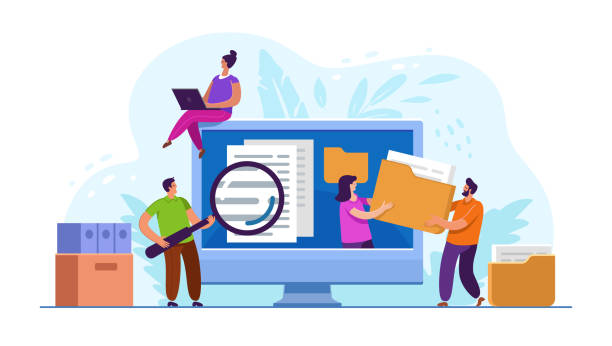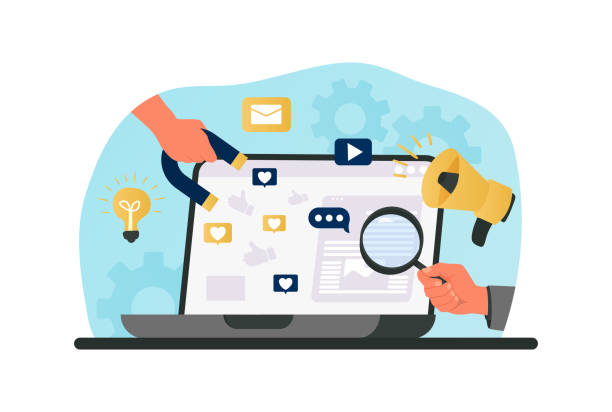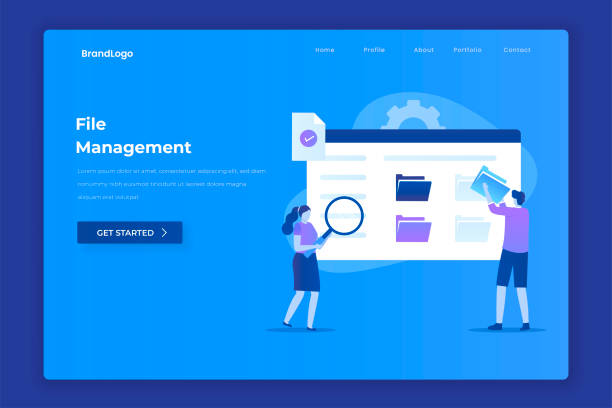The Importance of Secure Website Design in the Digital Age

In today’s world, where real and virtual boundaries are intertwined, having a website is not merely a competitive advantage but an undeniable necessity.
But the question is: Can every website meet your needs? The answer is a resounding no.
The importance of #SecureWebsiteDesign is growing daily, as users’ personal and financial information, as well as businesses’ sensitive data, are exposed to countless cyber threats.
An insecure website can not only lead to a loss of credibility and customer trust but also result in heavy legal penalties and irreparable financial damages.
Malware attacks, phishing, data theft, and ransomware attacks are just a few of the dangers that threaten vulnerable websites.
Protecting user data and maintaining system integrity are the backbone of any successful online business.
Therefore, paying attention to #CyberSecurity from the initial stages of #WebsiteDevelopment is considered a vital investment for its future and sustainability.
This proactive approach, rather than a reactive one, ensures that your site is built with high security standards from the outset and is continuously fortified against new threats.
Tired of losing business opportunities due to not having a professional corporate website? Worry no more! With Rasaweb’s corporate website design services:
✅ Your brand’s credibility and professionalism will increase.
✅ You will attract more customers and sales leads.
⚡ Get a free consultation now to start!
Common Web Security Threats and Countermeasures

The digital world, while offering countless opportunities, also comes with extensive security challenges and threats.
Understanding these threats is the first step towards #SecureWebsiteDesign.
Among the most common #CyberAttacks targeting websites are SQL Injection, Cross-Site Scripting (XSS) attacks, Distributed Denial of Service (DDoS) attacks, and phishing attacks.
An SQL Injection attack allows the attacker to gain access to the database by injecting malicious code into the site’s inputs, thereby stealing or manipulating sensitive information.
XSS also allows the execution of malicious code in the victim’s browser.
DDoS attacks overwhelm the site’s server with massive traffic, rendering it inoperable and disrupting service.
Countering these threats requires a comprehensive approach that includes using Web Application Firewalls (WAFs), rigorous input validation, regular updates of systems and software, using strong encryption protocols, and implementing intrusion detection mechanisms.
Awareness of the nature of these attacks and the deployment of appropriate defensive tools are fundamental pillars in maintaining the security and stability of any website. Development teams must be familiar with the latest vulnerabilities and write their code in a way that blocks these security holes, which means a #MultiLayeredDefenseApproach against attackers.
Fundamental Principles of Secure Website Design

To achieve #SecureWebsiteDesign, simply installing a few security plugins is not enough; fundamental security principles must be integrated into the core of the development process from the outset.
One of these principles is the ‘Principle of Least Privilege,’ meaning that every user or system should only have the minimum access required to perform its tasks.
Another principle is ‘Defense in Depth,’ which means implementing multiple security layers, so that if one layer fails, the next layer can protect the system.
Using strong encryption to protect sensitive data both in transit and at rest is also crucial.
Furthermore, #UserInputValidation is essential to prevent injection and XSS attacks.
Every user input must be carefully examined and sanitized to prevent malicious code from infiltrating the system. Choosing secure frameworks and libraries, continuously updating used software, and conducting regular security tests are other measures that help increase the site’s resistance to attacks.
Adhering to these principles not only prevents attacker intrusion but also facilitates the recovery process after a security incident.
| Feature | Secure Website Design | Insecure Website Design |
|---|---|---|
| Input Validation | Always validates and sanitizes inputs | Accepts inputs without validation |
| Use of HTTPS | Always has HTTPS enabled | Uses plain HTTP |
| Password Management | Hashes and salts passwords | Stores passwords in plain text |
| Updates | Applies security updates promptly | Neglects updates |
| Error Reporting | Manages errors without revealing internal details | Displays sensitive server information in errors |
The Role of SSL/TLS Certificates in Securing Communications

One of the most fundamental yet crucial steps in #SecureWebsiteDesign is the use of SSL/TLS certificates and the HTTPS protocol.
SSL (Secure Sockets Layer) and its successor TLS (Transport Layer Security) are protocols that encrypt the communication between the user’s browser and the website’s server.
This encryption ensures that all information transmitted between the user and the site – including login details, credit card information, and personal data – is protected against eavesdropping and tampering by third parties.
Websites that do not use HTTPS are not only at risk of information eavesdropping but are also marked as “insecure” in browsers, which severely damages credibility and user trust.
Furthermore, search engines like Google give better rankings to websites that use HTTPS.
Proper installation and configuration of SSL/TLS is an integral part of a #WebSecurity strategy and goes beyond just a green padlock icon in the address bar.
These certificates also verify the website’s identity, ensuring that the user is communicating with the real site and not a phishing site.
For #BuildingSecureWebsites, choosing an appropriate certificate (such as DV, OV, EV) depending on the site’s needs and data sensitivity is of particular importance.
Tired of losing business opportunities due to not having a professional corporate website? Worry no more! With Rasaweb’s corporate website design services:
✅ Your brand’s credibility and professionalism will increase.
✅ You will attract more customers and sales leads.
⚡ Get a free consultation now to start!
Secure Database Management and Preventing Data Leaks

The database is the heart of every website, containing the most valuable information, including user data, transaction records, and site content.
Therefore, #DatabaseSecurity is an integral part of #SecureWebsiteDesign.
One of the biggest threats to databases is SQL injection attacks, which allow attackers to access the database with malicious code.
To counter these attacks, using Parameterized Queries or Prepared Statements is essential.
This method ensures that input data is never interpreted as executable code.
Additionally, strict database access control must be implemented, meaning that each part of the application or every user only has the minimum necessary privileges to perform their tasks.
Encrypting data at rest and in transit is also vital for protecting sensitive information.
Also, strong passwords should be used for database access and changed regularly.
Regular and secure backups of the database and storing them in a safe, separate location are also essential for data recovery in case of security incidents.
Proper configuration of the database server and removing unnecessary functionalities also help reduce the attack surface.
These comprehensive measures ensure the protection of your #ConfidentialData.
User Authentication and Access Management

Another key aspect in #SecureWebsiteDesign is implementing strong #Authentication and #UserAccessManagement mechanisms.
Authentication means verifying the identity of a user attempting to log into the site, while access management (Authorization) determines which sections or information the user can access after logging in.
For authentication, it is essential to use strong and complex passwords that include uppercase and lowercase letters, numbers, and symbols.
More importantly, passwords should never be stored in plain text in the database; instead, they should be stored using strong hashing algorithms along with a salt, so they remain unreadable even if the database is leaked.
Implementing Two-Factor Authentication (2FA) or Multi-Factor Authentication (MFA) significantly enhances the security of user accounts, as it requires an additional factor (such as an SMS code or biometric verification) besides the password.
In the access management section, the Role-Based Access Control (RBAC) model is highly recommended.
This model grants specific access permissions to each user based on their role in the system, which prevents the granting of unnecessary additional privileges and doubles the stability of your #SecuritySystem.
Secure Coding and Vulnerability Prevention

The foundation of any #SecureWebsiteDesign is secure coding.
Many security vulnerabilities originate from weak and insecure code.
Attackers can infiltrate systems by exploiting these loopholes.
The OWASP (Open Web Application Security Project) organization publishes a list of the Top 10 web vulnerabilities, which can be a useful guide for developers.
These vulnerabilities include Injection, Broken Authentication, Sensitive Data Exposure, and Security Misconfiguration.
To prevent these issues, developers must continuously receive training and be familiar with the best practices of #SecureCoding.
Using secure and up-to-date frameworks, sanitizing user inputs, employing secure functions for encryption and hashing, and proper error handling are among the practices that must be observed.
Furthermore, conducting regular security audits and tests on the code, such as Penetration Testing and Static Code Analysis, can help identify and fix vulnerabilities before they are discovered by attackers.
A small error in the code can lead to a major security flaw, so meticulous attention to detail is crucial in the #SecureWebsiteDevelopment process.
| Vulnerability | Brief Description | Key Solution |
|---|---|---|
| Injection | Sending malicious data executed as commands | Use of Prepared Statements/Parameterized Queries |
| Broken Authentication | Weak implementation of login and session management mechanisms | MFA, strong passwords, secure session management |
| Sensitive Data Exposure | Insufficient protection of sensitive data at rest and in transit | Strong encryption, use of HTTPS |
| XML External Entities (XXE) | Processing insecure XML inputs | Disabling XXE processing |
| Broken Access Control | Inability to properly enforce access restrictions | Implementing RBAC, thorough access testing |
Monitoring, Incident Response, and Regular Backups

Even with the most rigorous adherence to #SecureWebsiteDesign principles, no system is one hundred percent impenetrable.
For this reason, having a comprehensive strategy for #SecurityMonitoring, #IncidentResponse, and #RegularBackups is of vital importance.
Continuous monitoring of logs and network traffic can identify early signs of attacks.
SIEM (Security Information and Event Management) tools can help collect and analyze these logs and issue real-time alerts.
After identifying an incident, having a well-defined #IncidentResponse Plan is essential.
This plan should include phases of identification, containment, root cause analysis, recovery, and lessons learned, so teams can react quickly and effectively to attacks and minimize damage.
Alongside these, regular and secure backups of all website data and code are your last line of defense.
Backups should be performed automatically, and backup copies stored in secure and separate locations (preferably off-site). These measures not only help you recover your site in case of serious attacks like ransomware but also provide the necessary assurance to continue business operations in an insecure environment.
In the era of #CyberSecurityNews, preparedness and quick response are key to survival.
Does your current corporate website not reflect your brand’s credibility and strength as it should? Rasaweb solves this challenge for you with professional corporate website design.
✅ Increased credibility and visitor trust
✅ Targeted attraction of more customers
⚡ Click to get a free consultation!
User Education and Awareness; The First Line of Defense

In any #SecureWebsiteDesign strategy, the human element cannot be overlooked.
Many successful cyberattacks occur not due to technical weaknesses but due to human errors and user unawareness.
#SocialEngineering and #Phishing attacks are among the most common methods through which attackers deceive users into revealing sensitive information or installing malware.
Therefore, #CyberAwareness and continuous user education, both for internal organizational users and website customers, are the first and perhaps most important line of defense.
Users should be educated about the importance of using strong passwords, identifying suspicious emails, avoiding clicking on unknown links, and protecting their personal information.
Training programs should be designed to be engaging and entertaining and encourage active user participation.
Conducting regular training courses, providing accessible educational resources, and fostering an organizational culture based on security significantly help strengthen this line of defense.
An informed user is the best protector of their own information and, consequently, the security of the entire system.
This approach transforms #QuestionableContent regarding unsafe behaviors into guidance for improvement.
The Future of Secure Website Design and Upcoming Challenges

With the continuous advancement of technology, the landscape of #SecureWebsiteDesign is also constantly evolving.
New challenges such as AI threats, more sophisticated attacks, and the need for privacy protection in Big Data are emerging.
In the future, we will see increased use of #ArtificialIntelligence and machine learning in security tools to detect anomalous patterns and predict attacks.
Blockchain may also play a significant role in securing data and decentralized authentication.
However, attackers will not remain idle and will leverage these same technologies to develop more complex attacks.
The main challenge in the future will be maintaining a balance between security, usability, and performance. Developers and security professionals must constantly learn and update their knowledge to withstand emerging threats.
Data privacy regulations such as GDPR and CCPA will also become stricter over time, and compliance with them will become a core pillar of #WebsiteSecurity.
#TrendAnalysis shows that cooperation between security professionals, organizations, and governments will be crucial for combating cyber threats on a global scale.
This means an endless path of innovation in the #SecureDevelopmentProcess.
Frequently Asked Questions
| Row | Question | Answer |
|---|---|---|
| 1 | What is secure website design? | Secure website design is a process in which websites are built with security measures in mind from the initial stages of development to protect against cyberattacks, unauthorized access, and data loss. |
| 2 | Why is secure website design important? | Website security is crucial for maintaining user trust, protecting sensitive information (personal and financial), preventing damage to brand reputation, and complying with privacy and security regulations (such as GDPR). A security breach can lead to financial and legal damages. |
| 3 | What are the most common cyberattacks a website faces? | Some of the most common attacks include SQL Injection, Cross-Site Scripting (XSS), Distributed Denial of Service (DDoS), Brute Force, and Credential Stuffing attacks. |
| 4 | What is SQL Injection and how can it be prevented? | SQL Injection is an attack where an attacker attempts to manipulate the database or extract information by injecting malicious SQL code into the site’s inputs. To prevent it, Prepared Statements/Parameterized Queries, ORM (Object-Relational Mapping), and rigorous input validation should be used. |
| 5 | What is Cross-Site Scripting (XSS)? | XSS is an attack where an attacker injects malicious scripts (usually JavaScript) into web pages, which are then executed by other users’ browsers. This can lead to the theft of cookies, session information, or alteration of the website’s appearance. |
| 6 | How can Brute Force attacks on login pages be prevented? | To prevent Brute Force attacks, CAPTCHA, limiting the number of failed login attempts (Account Lockout), Two-Factor Authentication (2FA), and using complex and long passwords should be employed. |
| 7 | What is the role of HTTPS in website security? | HTTPS encrypts the communication between the user’s browser and the website’s server using SSL/TLS. This prevents eavesdropping, tampering, or forgery of information during transmission and increases user trust. |
| 8 | What is the importance of Input Validation in security? | Input validation is the process of checking and sanitizing data entered by the user. This prevents malicious code injection, XSS attacks, SQL Injection, and other vulnerabilities, ensuring that the data conforms to the expected format. |
| 9 | Why are regular updates of website systems and software necessary? | Regular updates of the operating system, CMS (like WordPress), plugins, themes, and libraries used address known security vulnerabilities. Hackers often exploit weaknesses in outdated software to infiltrate. |
| 10 | What role do regular backups play in secure website design? | Regular and tested backups of website data (database and files) are a vital layer of defense against data loss due to cyberattacks, human errors, or hardware failures. This enables quick website recovery in case of a disaster. |
And other advertising services of Rasaweb Advertising Agency
Smart Google Ads: Professional optimization for campaign management using SEO-driven content strategy.
Smart Customer Journey Map: A dedicated service for growing website traffic based on intelligent data analysis.
Smart Content Strategy: An innovative service for increasing campaign management through proprietary programming.
Smart Website Development: A professional solution for customer acquisition focusing on the use of real data.
Smart Marketplace: A dedicated service for online growth based on SEO-driven content strategy.
And over hundreds of other services in the field of internet advertising, advertising consultation, and organizational solutions.
Internet Advertising | Advertising Strategy | Advertorial
Sources
Secure Website Design on Zoomit
Web Design Articles on Digikala Mag
Website Security in Iran
ISNA News Agency – Website Design
? If you are looking to elevate your business’s position in the online space, Rasaweb Afarin Digital Marketing Agency, with its expertise in corporate website design and offering comprehensive digital marketing solutions, is ready to assist you on your path to achieving your goals.
📍 Tehran, Mirdamad Street, next to Bank Markazi, Southern Kazeroon Alley, Ramin Alley, No. 6


